WASHINGTON, DC – Latin American and Caribbean (LAC) cities have the potential to boost their economies by better integrating migrants, according to a new report by the Inter-American Development Bank (IDB).
 The report, titled, “Rethinking Urban Migration: Policy Options for Cities in Latin America and the Caribbean” is part of the IDB’s Microeconomic Reports series.
The report, titled, “Rethinking Urban Migration: Policy Options for Cities in Latin America and the Caribbean” is part of the IDB’s Microeconomic Reports series.
It argues that, by successfully integrating well-trained and highly productive migrants into urban economies, local policymakers can set the course for economic growth in their cities.
“By better integrating migrants, cities can tap into a dynamic labor force with a wealth of skills and perspectives that can drive innovation and productivity, leading to increased community competitiveness and prosperity,” said Eric Parrado, the IDB’s chief economist and general manager of the Research Department.
The report outlines two key areas for policymaking, namely promoting migrants’ contributions to local productivity and alleviating housing constraints. It suggests a range of interventions, from transportation investments and zoning policies to public employment services and childcare assistance.
The new report offers a different perspective on urban migration by focusing on its role in the economic development of cities across the region, shifting the traditional debate that has often centered around potential challenges.
It acknowledges these challenges, such as housing and employment, but emphasizes that they should not overshadow the long-term economic benefits of integrating migrants. Policymakers are encouraged to implement strategies that not only address immediate concerns, but also focus on maximizing the economic contributions of migrants.
Urban migration presents several opportunities for economic growth. The report finds that migrants tend to be younger and have fewer dependents so that, if adequately employed, they can have more resources available for spending on goods and services, saving, or investing.
The average age of migrants in Latin America and the Caribbean is 30.4 years, compared to 36.7 years for residents.
The IDB said that cities play a significant role in the economic development of countries, particularly in Latin America and the Caribbean. It said while urban areas cover less than 0.7 per cent of the region’s landmass, they are home to almost 82 per cent of the total population, up from 50 percent in 1960.
According to the report, cities offer larger markets and foster the exchange of ideas, which can make businesses more productive. However, the region has historically experienced slow productivity growth, indicating that its urban centers could do more to change this trend.
As policymakers evaluate options, they should consider short-term versus long-term scenarios, tailor policies to specific contexts, engage the private sector, strengthen local institutions, and prioritize measures that benefit both migrants and residents.
Other notable findings from “Rethinking Urban Migration” include climate change will likely accelerate migration over the coming decades.
Climate events, both sudden such as hurricanes, tornadoes, floods and slow-onset -droughts, rising sea levels, desertification – will continue to drive significant migration flows in the region. A one-point increase in dryness is associated with a 2.5 percentage point increase in cities’ immigration rates from rural municipalities.
The report also notes that while large cities remain primary destinations for internal migrants, small and medium-sized cities also experience substantial migration.
It says a total of 70 per cent of migrants in urban areas are internal migrants, moving within their countries’ borders. However, international migration within the region has increased by more than 80 per cent from 2015 to 2020.
International migrants constitute 2.6 per cent of the total urban population in Latin America and the Caribbean, whereas internal migrants account for 6.2 per cent, the report added.


